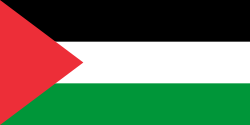Hamas Government of June 2007 | |
|---|---|
| Date formed | 14 June 2007 |
| Date dissolved | September 2012 |
| People and organisations | |
| Head of state | Mahmoud Abbas (not recognized by Hamas) |
| Head of government | Ismail Haniyeh |
| No. of ministers | 13 |
| Member party | Hamas |
| Status in legislature | Palestinian Legislative Council (not recognized by Hamas) |
| History | |
| Predecessor | Palestinian Unity Government of March 2007 |
| Successor | Second Hamas Government of September 2012 |
 |
|---|
The Hamas government of June 2007 led by Ismail Haniyeh of Hamas was the de facto government in the Gaza Strip after a fierce inter-factional Palestinian warfare in the Gaza Strip, in which Hamas ousted Fatah from the Gaza Strip. The Hamas government was not appointed by PA President Mahmoud Abbas nor approved by the Palestinian Legislative Council (PLC). It exercised de facto rule over the Gaza Strip, and was not recognised by any foreign government.
Contents
On 14 June 2007, President Abbas dismissed the Haniyeh-led Palestinian unity government of March 2007 and appointed a Fatah-led PA government. Abbas also suspended articles in the Basic Law to dispense with the need for the Fatah government to obtain PLC approval. The PA government was widely recognized as the representative government of the Palestinian National Authority, the de jure authority in the Palestinian territories, with de facto control only in the West Bank. However, Haniyeh and Hamas claimed the Fatah-led PA government was illegitimate and unconstitutional.
The Hamas government of June 2007, in parallel with the Fatah-led PA government of June 2007, succeeded the Palestinian unity government of March 2007. [1] Haniyeh reshuffled the Hamas government in September 2012, which is regarded as the second Hamas government in the Gaza Strip.